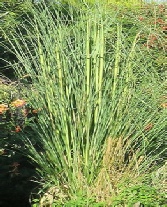





Gardening: Appreciating Change: (3) Plant Life Changes
Picking up the Threads
We continue to meander along this path that browses the changes that face us as gardeners. In the previous article we pondered on the impact of major weather changes and then of that caused by the seasons. These are changes brought about by influences beyond our control but which cause us to respond in terms of what we then do with our garden. I want to move on to more general, less controlling influences but before we do that there is one more area of change that takes place in the average garden, which is largely beyond our control but leaves you wondering. OK, here we go, the next change.
3. By Growth, Maturity & Death
The fact is stuff grows! Indeed, whether we are conscious of it or not, deep down we want it to grow. When you sow seeds, you want them to grow; when you grow on plant plugs, you want them to grow. When you are growing vegetables the whole point is you want them to grow. If you plant a sapling, you have it in mind that you want it to grow into a mature tree. If you plant hedge cuttings, you want them to grow, develop, fill out and form a full-
Having just excluded sunshine from our areas of influence, I realise that this is not strictly so. The fact is that some plants like shade while others like full sunshine and there are those in between that like sun but not too much of it, i.e. they like semi-
But growth can bring its own problems, if problems they are. In some instances too much growth requires us to take action. The change being forced upon us can get out of hand. I am not one of those who gets scared by the use of the word, ‘Leylandii’. I have used them to create a substantial hedge to obscure an otherwise boring fence, they do provide nesting places for birds but their propensity to grow fast does means we have to keep on top of them. I am aware that as far as the neighbours are concerned they can be a cause of light obstruction and I have sympathy for the neighbours who suffer in this way. While we do have a substantial hedge made from them – and I continue to lengthen it – we have also had those that were freestanding and eventually were becoming a worrying feature and so last year I cut own and removed some eight such trees. It’s a big job, one to be avoided by keeping the tree down to say six or seven feet (and thus becomes more of a hedge) – or, of course, not planting them at all. Having said that as I look around the landscape, there are plenty of other tall if not bulky trees around the place that never raise an eyebrow. They tend to be the deciduous trees that are only there claiming our attention for half of the year. Perhaps that is the reason we like them.
Now let’s state something else you may think is obvious about creating the change. Plants grow with the help of sunshine, water and the soil. The sun you can’t do much about, but in the absence of rain, regular watering is essential if you want plants to flourish. In the case of vegetables especially, new plants every year means the soil will become depleted of nourishment and so we move into the realm of composting, top feeds, and feeds generally. The only point I make here in this context, is that each of these things (excluding sunshine) is something that we can do to influence the change (growth).


But it is not only trees or bushes that can grow and demand our attention. A number of years ago I bought a pampas grass that I was sure had a label on it that said it was a miniature that would only grow to four or five feet. When it reached ten feet, my wife complained it was obscuring the bird feeder and so instead of moving the bird feeder I had to dig out and move this most amazing plant. When you have to do that, it is the obvious time to split the plant with a sharp spade. We now have four pampas grasses spread strategically around the garden that are starting, after a year, to regrow. I use the word ‘strategically’ because, of course, the ‘grass’ of the pampas is sharp and hostile and needs to be kept back well away from the likelihood of human contact.

But it extends from trees, bushes & grasses to include flowers generally sometimes. Historically I have never been a dahlia fan but a half decade back I ventured into this area and found they were beautiful and bushy, so bushy in fact that I realised I had planted them too close to a path. When I relocated them into a larger bed, they celebrated this fact by growing even more and more. I didn’t know they could grow to over eight feet in height.
Size and shape are real expressions of change and when they get out of hand, whether overflowing onto paths or cutting out light to plants that need light, or simply taking over the harden to the detriment of everything else, then action is demanded to reshape or resize. So you either decide to control by cutting back or you allow the garden to run amok and follow its own tendencies.
Death has a habit of turning up unexpectedly in the garden (and I don’t mean dead birds etc.). Sometimes the signs are there for a long time. We inherited an old apple tree that was massive – no fruit but massive! It became the home for a tree house for the kids for a number of years. It was too old and too far gone for spraying to have any effect. Fortunately the era of the tree house has passed when I realised that some of the branches were rotten. With a trunk of about eighteen inches it presented us for a formidable problem. When I came to dig around the base of it’s trunk I was amazed to find rot below the soil level and when I gave it a big push, the entire tree just fell over. Impressive he-
Then there was the amazingly prolific pear tree that was just so prolific we really didn’t know what to do with all the fruit. It continued to grow and grow upwards so every five years I would take a ladder and scale the heights and take out the top five or six feet. It carried on regrowing year after year and so I continued to make five yearly pilgrimages to the top of this massive tree – until one day a large branch literally broke off under by feet, rotten! That’s it, said my wife, I’m not having you falling out of trees, it’s got to come down! With nine or ten inch diameter branches that were so massive in their own right, and so heavy, it was possibly one of the most dangerous exercises I’ve ever carried out in this garden. Change can be life threatening!
Another smaller pear tree was just simply so old that it too decided enough was enough and so that has been the latest in a long line of features of the garden that are no longer there.
And then we had a massive lilac bush, about eight feet across. One day we looked at each other and said, “That bush is dying.” I’ve checked up on reasons that bushes, trees or plants generally die and it is not always lack of care. As someone once said to me, sometimes they just come to the end of their life and die, and that’s it. Sometimes it is disease.
Now whether it be a tree or large bush, you can either mope over its demise or you can see it as an opportunity to bring further change. The apple tree now has a workshop in its space, the big pear tree is still a tall stump on which ivy grows and birds nest, the lilac bush has been replaced by a covered nursery area for plants, and the various Leylandii that have come down, have given way (after a lot of effort to remove the stumps) to additional flower beds. Yes, whenever there have been losses, new life has come in a variety of ways. Where the smaller and older of the two pear trees was removed, the space now has some paving slabs and a large tub in which now resides a dwarf pear tree. It’s sad to see ‘old friends’ go, but in a garden it is the way of life that for all of us is limited. Because we are the ones coping with the changes, we have the opportunity always to bring in some new facet to the wonderful world we’ve worked in for decades.
Well, that’s enough for now. In the next article we will go on to start considering the aspects of change that are more down to us rather than the things brought about by nature. See you in a bit.
PS. Within a few days of writing this article we suddenly started noticing that each of the half a dozen low box hedges we have are showing signs of Box Blight. If you are are Gardeners’ World and Monty Don fan, you will know that he has spoken about this over a year back. We had rejoiced that what was in Herefordshire hadn’t got here. It has! You can fight it with some sorts of Box but we are now hastily cutting back and disposing of the affected bushes. It’s a sad time because these were beautiful hedges but what did this optimist say? Every death is an opportunity to think new things? OK, what are we going to replace these hedges with? Time for thought as well as action. More change!